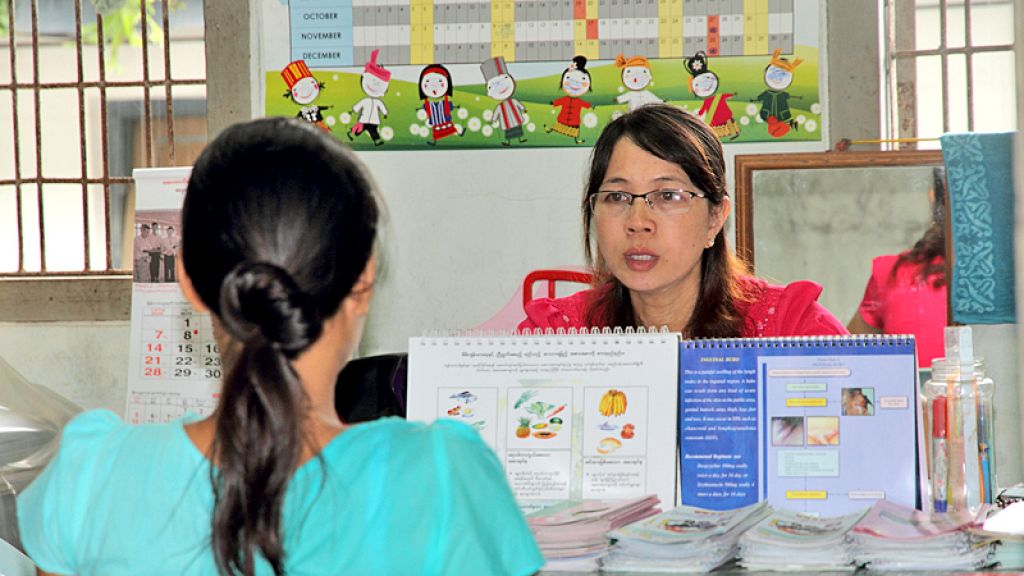Greater Mobility in Myanmar Raises Risks of Communicable Disease Contagion

In addition to prevention activities, a project to mitigate the spread of HIV/AIDS in Myanmar will support treatment and care services, the construction of rural health centers, and enhanced service delivery in hundreds of villages. Photo: ADB/Myo Thame.
The Mon State Health Department’s HIV/AIDS Clinic-Hospital is on the front lines of Myanmar’s HIV/AIDS prevention efforts. On the day of our visit, clients waiting to get a checkup queue in the hallway. In one room, two university women are getting free confidential tests. In another, a woman quietly weeps as she’s told that she’s tested positive. A medical doctor who runs the clinic, Thant Zin Min, says while great strides have been made in HIV/AIDS prevention and treatment efforts over the past decade, much more needs to be done. “We need stronger interventions with commercial sex workers and other at-risk groups so they can have early access to treatment and support,” he says.
Unintended consequence of greater mobility
ADB is proposing the upgrade of a road in Myanmar’s Kayin state that will complete the East-West Economic Corridor, stretching from Danang, Viet Nam to the Andaman Sea in Myanmar. While the new road will bring a range of benefits, growing trade and travel will also invariably increase the risk of HIV/AIDS transmission.
“When you build a road there are always downsides, one of which is communicable diseases like HIV/AIDS,” says ADB’s Myanmar Country Director Winfried Wicklein. “That is why we build HIV/AIDS prevention into all of our road projects. For this project we’ll be working with local communities to support awareness and prevention programs.”
ADB is supporting a project to mitigate the spread of HIV/AIDS along the East-West Economic Corridor in Myanmar. In addition to prevention activities, the project will support treatment and care services, the construction of rural health centers, and enhanced service delivery in hundreds of villages. ADB is already supporting surveillance work being carried out by the International Organization for Migration (IOM).
“We’re [currently] mapping migrant clusters and other at-risk populations like commercial sex workers and truck drivers,” explains Dr. Kyaw Myint Htun, IOM’s research coordinator for HIV prevention. “People don’t always think of migrant workers when they think of high-risk groups, but migrant workers on road projects are usually men, and they are usually living away from their families for long periods of time. This puts them at higher risk.”
Different approaches for different settings
Since work sites are not recognized as villages, Kyaw Myint Htun says that proactive consultation is especially critical for locating the most vulnerable population groups and identifying intervention strategies. “Different settings call for different approaches,” he says. “For migrant workers we have different videos we show that are a starting point for conversation later. For other at-risk groups like commercial sex workers we might use peer-to-peer education with condom distribution. The need for prevention and treatment is already massive, and will likely grow as Myanmar further opens up its borders.”
“When the Asia Highway is established, there will be more cross-border migrants, more truck drivers, and my point of view is that this will have a huge impact on the HIV transmission risk,” says Thant Zin Min. “So we will need to take even greater care when it comes to HIV prevention. More information and support for mobile populations. More support for prevention, treatment, and early diagnosis.”
He is particularly worried about mobile populations, like truck drivers, who are more difficult to target with outreach since they are always on the move, and whose numbers will increase when the new road opens.
Most truck drivers are aware of the risk of HIV, but an alarming proportion also acknowledges meeting commercial sex workers while they’re on the road.
“A lot of drivers visit prostitutes, but most do [ask] use a condom,” says one truck driver on the road outside of Kawkareik. “And most of the truck drivers will say yes.”
But that is not always the case. A peer educator working out of the Mawlamyine clinic says that while most commercial sex workers use condoms, some also make exceptions.
“That’s how I got HIV,” she says. “When I was doing that work I knew about HIV/AIDS, but I didn’t always want to listen about prevention, and I didn’t always do what I needed to do to take care of myself.”
Nevertheless, there is broad agreement from those on the forefront of this fight that active prevention and service programs can make an enormous difference.
“Awareness-raising is so important, and if we can provide the right information in the right way, and really improve people’s understanding about HIV transmission, I believe we can control it,” says Thi Thi Nwe, leader of a self-help group for people living with HIV/AIDS in Mawlamyine.
Source: ADB.org
Last Updated: 1 November 2014
